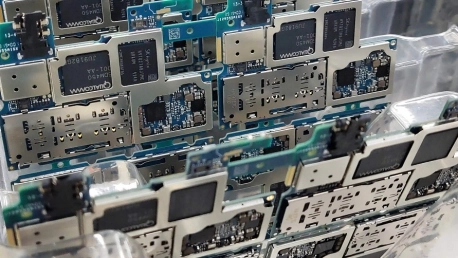Mobile devices have become an integral part of our daily lives. From the moment we wake up to the sound of our alarms, through our work, entertainment, and even as we wind down with a bedtime podcast, our smartphones and tablets are always within reach. This pervasive presence of mobile devices has revolutionized the way we communicate, work, and interact with the world around us. However, have you ever stopped to ponder what makes these devices so smart and capable?
The Ubiquity of Mobile Devices
The proliferation of mobile devices is nothing short of astonishing. The statistics are staggering; there are now more active mobile devices on Earth than there are people. This ubiquity extends from bustling city streets to remote villages, connecting individuals across continents and cultures. While the sleek screens and intuitive interfaces of these devices capture our attention, the true magic happens beneath the surface, where sophisticated hardware components work tirelessly to deliver the seamless experience we’ve come to expect.
The Crucial Role of Mobile Processors
At the heart of every mobile device lies a critical component that drives its performance and capabilities: the mobile processor. Often referred to as the “brain” of the device, the mobile processor is the unsung hero responsible for executing tasks, running applications, and enabling us to capture stunning photos, watch high-definition videos, and play graphically demanding games. To truly appreciate the marvel of modern mobile processors, we must embark on a journey deep into the heart of these tiny powerhouses.
This article will explore their fundamental components, the architecture that governs their operations, and examine the innovations that have propelled them to astounding heights of performance and efficiency. Whether you’re a tech enthusiast seeking a deeper understanding or an everyday user curious about the inner workings of your beloved device, this exploration promises to be enlightening and rewarding.
The Basics of Mobile Processors
Think of your mobile processor as the brain and nerve center of your smartphone or tablet. It’s responsible for making everything happen, from opening apps to streaming videos and even handling complex tasks like gaming.
The Core Components
At the heart of every mobile processor are its core components, and the most essential of these is the CPU, or Central Processing Unit. If your smartphone is a city, the CPU is the mayor—it calls the shots. It’s responsible for executing instructions and performing calculations that drive the device’s functions. Modern mobile processors also boast other cores, like the GPU (Graphics Processing Unit), which handles all those breathtaking graphics in games and videos, and the AI (Artificial Intelligence) cores, which make your device smarter by processing machine learning tasks.
Clock Speed and Performance
You’ve probably heard about clock speed when it comes to processors. It’s measured in GHz (gigahertz), and the higher, the better, right? Well, not always. Clock speed is just one piece of the puzzle. Modern processors are incredibly efficient, so they can do more with lower clock speeds. It’s like having a car with an efficient engine that doesn’t need to rev too high to deliver impressive performance. So, don’t judge a processor solely by its clock speed!
Manufacturing Process
Ever wonder why some processors are snappier and more power-efficient than others? It’s because of the manufacturing process. Processors are made using nanometer technology. Smaller nanometers mean a more efficient processor. Think of it like building a tiny, high-tech city on a smaller scale. As of now, 7nm and 5nm are the gold standards for mobile processors, and they’re the ones that make your device feel lightning fast while sipping on your battery juice.
Multitasking Magic
One of the coolest things about mobile processors is their ability to multitask like a champ. Thanks to multiple cores, your processor can juggle different tasks simultaneously. Whether you’re streaming music, navigating with GPS, and texting your friends all at once, your trusty processor ensures everything runs smoothly.
Inside the Mobile Processor
Let’s take a closer look at the architectural wonders that make up a mobile processor. You’ll be amazed at the intricate design and engineering that goes into these tiny powerhouses.
FinFET Technology
FinFET stands for “Fin Field-Effect Transistor,” and it’s a design breakthrough that allows for better control of the flow of electrical current. Imagine tiny, 3D “fins” on the transistor that help regulate the flow. This innovation reduces power leakage and boosts efficiency, making your device both faster and more energy-efficient. It’s like having a finely tuned sports car engine under the hood of your smartphone.
Cache Memory
Mobile processors have a special type of memory called “cache”. It’s like having a small, super-fast storage area that holds frequently used data. This nifty feature saves your processor from constantly fetching data from the slower main memory (RAM), making your device feel snappier.
Power Efficiency
When you think about mobile processors, power efficiency is king. The architecture of these chips is designed to strike a delicate balance between performance and energy consumption. That’s where things like “big.LITTLE” architecture come into play. It’s like having a versatile toolset at your disposal. The “big” cores handle heavy lifting when you need maximum performance, while the “LITTLE” cores take over for everyday tasks, sipping on power like a fine wine. The result? Impressive performance when you need it and longer battery life when you don’t.
Integrated vs. Dedicated Graphics
Graphics are a big deal in the world of mobile processors, especially if you’re into gaming or creative tasks. Some processors have integrated graphics, which share resources with the CPU. Others boast dedicated GPUs (Graphics Processing Units) that handle graphics tasks separately. It’s like the difference between a versatile multitool and a specialized tool designed for a specific job. Integrated graphics are great for everyday use, while dedicated GPUs shine in resource-intensive applications.
What Lies Ahead for Mobile Processors?
One of the most intriguing developments in the world of mobile processors is the relentless pursuit of miniaturization. You’ve probably heard of Moore’s Law, which states that the number of transistors on a microchip doubles approximately every two years, leading to increased processing power. However, we’re pushing the boundaries even further into nanometers. Today’s cutting-edge processors are manufactured using processes as small as 5nm. To put that into perspective, a human hair is about 75,000nm thick! This nanoscale manufacturing allows for more transistors, greater efficiency, and improved performance while sipping less power.
The Rise of Neural Processing Units (NPUs)
Artificial Intelligence (AI) is poised to play an even more significant role in the future of mobile processors. We’re seeing more and more dedicated AI cores, known as Neural Processing Units (NPUs). These specialized cores are tailor-made for AI-related tasks, like image recognition and natural language processing. Imagine having a virtual assistant that not only understands your voice commands but also comprehends the context of your requests, making your interactions with your device more intuitive and efficient.
Exploring Quantum Processors
While quantum processors are still in their infancy, they hold the promise of revolutionizing computing as we know it. Unlike classical processors that use bits (0s and 1s), quantum processors use quantum bits or qubits. These qubits can exist in multiple states simultaneously, enabling them to process vast amounts of data in parallel. Quantum processors have the potential to tackle complex problems in fields like cryptography, materials science, and drug discovery, unlocking new frontiers in technology.
The Green Revolution: Sustainable Processing
Sustainability is a growing concern in the tech world, and it’s making its way into mobile processors. Future processors will not only focus on performance but also on energy efficiency. Imagine a world where your device’s performance scales up when needed but conserves power when idle, reducing your carbon footprint. Sustainable processing is not just a buzzword; it’s a commitment to a greener, more eco-friendly tech landscape.
The Bottom Line
In the anatomy of mobile technology, processors are like the beating heart within our devices. They tirelessly pump power and performance into our digital experiences, ensuring that our gadgets run smoothly and efficiently.
When looking closer into the inner workings of these processors, it becomes clear that they are the architects of the digital ecosystem. They design the pathways for data, construct the bridges between applications, and ensure that everything runs in perfect harmony.
Looking ahead, the future of mobile processors promises even more exciting developments. From turbocharged speed to eco-friendly designs, these tiny powerhouses are set to continue revolutionizing the way we interact with technology.









